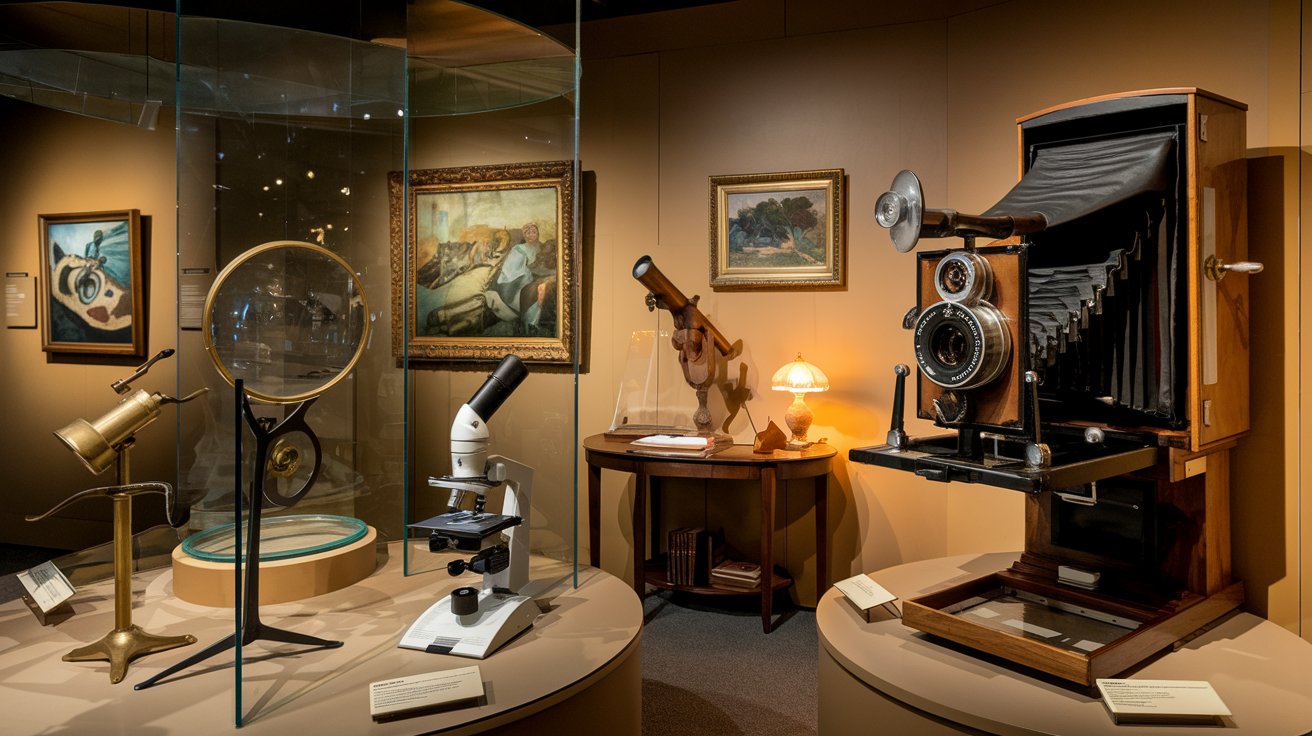
Optics, the study of light and its interactions with matter, has a rich history spanning thousands of years. From ancient lenses made of polished crystal to modern optical instruments, the field has evolved significantly. Early civilizations like the Egyptians and Mesopotamians crafted the first lenses around 2000 BC. Greek philosophers debated theories of vision, while medieval scholars linked optics to theology. The invention of spectacles in the 13th century marked a practical leap. Later, the development of microscopes and telescopes revolutionized science. Today, optics plays a crucial role in technologies like fiber optics, digital cameras, and the Hubble Space Telescope.
Key Takeaways:
- The history of optics dates back thousands of years, with ancient civilizations like the Egyptians and Greeks making significant contributions to our understanding of light and vision.
- From the invention of spectacles in the Middle Ages to the development of modern optical instruments, optics has played a crucial role in shaping our understanding of the microscopic and cosmic worlds, as well as in everyday technologies like photography and television.
Ancient Beginnings of Optics
Optics has roots stretching back thousands of years. Early civilizations were already experimenting with light and lenses, laying the groundwork for future discoveries.
-
Ancient Origins: The study of optics began with the ancient Egyptians and Mesopotamians, who developed lenses from polished crystal around 2000 BC in Crete and 700 BC in Rhodes.
-
Early Lenses: Assyrian lenses, like the Nimrud lens from around 700 BC, were used for magnification and focusing light.
Greek Contributions to Optics
The Greeks made significant strides in understanding light and vision, contributing theories and mathematical principles that influenced later work.
-
Greek Contributions: Euclid's treatise "Optics" linked vision to geometry and described the mathematical rules of perspective.
-
Greek Theories: Greek philosophers debated two main theories of vision: the intromission theory and the emission theory. The intromission theory suggested objects cast off copies of themselves (eidola) captured by the eye.
-
Emission Theory: Plato's emission theory posited that visual perception occurred through rays emitted by the eyes.
-
Euclid's Optics: Euclid's "Optics" proposed that visual rays are straight lines and defined the apparent size of an object by the angle formed by rays from the object to the observer's eye.
-
Ptolemy's Treatise: Ptolemy's extensive work on optical phenomena covered geometric optics, catoptrics, and experimental areas like binocular vision.
-
Diocles' Studies: Diocles proved that a paraboloid of revolution reflects rays from the Sun to a single point, a concept still of interest in the 6th century AD.
-
Anthemius of Tralles: Known for his architectural work on the Hagia Sophia, Anthemius also compiled a survey of remarkable mirror configurations.
Medieval Optics and Early Instruments
During the Middle Ages, optics was intertwined with theology, but practical advancements like spectacles emerged.
-
Medieval Optics: Optics was seen as a way to understand God's creation, linking light study to theological discussions.
-
Bernard of Gordon: In the 13th century, Bernard of Gordon wrote about using spectacles to correct long-sightedness (hypermetropia).
-
Spectacles Evolution: Spectacles evolved from biconvex lenses to include concave lenses for near-sightedness, with the first wearable eyeglasses likely invented in Italy in the late 13th century.
Microscopes and Telescopes
The invention of microscopes and telescopes in the 16th and 17th centuries revolutionized our understanding of the microscopic and cosmic worlds.
-
Microscope Development: The compound microscope, using multiple lenses to magnify objects, was developed in the late 16th century, with the Dutch playing a key role.
-
Leeuwenhoek's Discoveries: Antonie van Leeuwenhoek used the compound microscope to observe microorganisms like bacteria and protozoa.
-
Hooke's Contributions: Robert Hooke coined the term "cell" while describing plant cell structures in "Micrographia" (1665).
-
Swammerdam's Work: Jan Swammerdam pioneered the use of microscopes for zoological studies, founding comparative anatomy and entomology.
-
Telescope Invention: Galileo Galilei constructed the first practical telescope for astronomical observation, revealing Jupiter's moons and supporting the heliocentric model.
Theories and Laws of Light
The 17th and 18th centuries saw the development of key theories and laws that shaped our understanding of light.
-
Fermat's Law of Refraction: Pierre de Fermat derived the law of refraction, stating that light always takes the path minimizing time.
-
Huygens' Wave Theory: Christiaan Huygens introduced the wave theory of light, explaining reflection and refraction through wave motion.
-
Newton's Corpuscular Theory: Isaac Newton's "Opticks" (1704) presented a particle theory of light, dominating scientific thought for over a century.
-
Young's Interference Experiments: Thomas Young's studies on interference supported the wave theory of light, later corroborated by Augustin-Jean Fresnel.
-
Fresnel's Contributions: Augustin-Jean Fresnel provided mathematical explanations for light wave behavior, laying the foundation for classical optics.
Modern Advances in Optics
The 19th and 20th centuries brought significant advancements in optics, from electromagnetic theory to practical applications like photography and fiber optics.
-
Maxwell's Electromagnetic Theory: James Clerk Maxwell's 1864 theory described light as electromagnetic waves, a major breakthrough in understanding radiant energy.
-
Polaroid Instant Photos: Edwin Land's invention of Polaroid instant photos revolutionized photography with polarized light filters for instant development.
-
Sunglasses and Protective Eyewear: Innovations in sunglasses and protective eyewear, from early glass lenses to modern polycarbonate and polarized lenses, have improved vision and eye protection.
-
Television and Video Technology: Optics principles have been crucial in developing television and video technology, from early cathode ray tubes to modern flat-screen displays.
-
Compact Discs (CDs) and Digital Cameras: CDs use laser technology to read data, while digital cameras use advanced sensors and lenses for high-quality images.
-
Fiber Optics Communications: Fiber optics communications use thin glass or plastic fibers to transmit light signals, enabling fast and reliable data transfer.
-
NASA’s Hubble Space Telescope: Launched in 1990, the Hubble Space Telescope's advanced optics have provided high-resolution images of distant galaxies and stars.
Advanced Optical Instruments
Modern optical instruments have evolved significantly, offering high-resolution imaging and new capabilities in various fields.
-
Optical Microscopes: Modern optical microscopes, with multiple lenses and advanced illumination systems, produce high-resolution images of microscopic structures.
-
Scanning Laser Confocal Microscopes: These advanced microscopes use lasers to produce high-resolution images of thin specimen sections, useful in biological research and medical diagnostics.
-
Bi-Convex Lenses: Cardano's description of bi-convex lenses in "De subtilitate rerum" improved image sharpness and intensity when used with a camera obscura.
-
Camera Obscura: This early optical device projects an inverted image of the outside world onto a surface, a precursor to modern cameras.
Public Engagement and Education in Optics
Educating the public about optics has been crucial for its advancement, with efforts to make the field accessible and understandable.
-
William L. Wolfe’s Contributions: William L. Wolfe, a professor at the College of Optical Sciences, dedicated his career to educating the public about optics through his book "Optics Made Clear."
-
Public Engagement in Optics: Scientists like Bill Wolfe have introduced the broader community to innovative research in optics through public lectures and educational presentations.
The Ever-Evolving World of Optics
Optics has come a long way from ancient crystal lenses to modern fiber optics. Early lenses from Egypt and Mesopotamia paved the way for Greek theories on vision. The Middle Ages brought practical tools like spectacles, while the Renaissance saw the birth of microscopes and telescopes. Scientists like Huygens, Newton, and Maxwell revolutionized our understanding of light. Fast forward to today, and we have advanced technologies like fiber optics, digital cameras, and the Hubble Space Telescope. Each milestone has built upon the last, driving both theoretical advancements and practical applications. Optics remains a vital part of our daily lives, influencing everything from medical diagnostics to space exploration. The journey of light continues, promising even more exciting discoveries and innovations in the future.
Frequently Asked Questions
Was this page helpful?
Our commitment to delivering trustworthy and engaging content is at the heart of what we do. Each fact on our site is contributed by real users like you, bringing a wealth of diverse insights and information. To ensure the highest standards of accuracy and reliability, our dedicated editors meticulously review each submission. This process guarantees that the facts we share are not only fascinating but also credible. Trust in our commitment to quality and authenticity as you explore and learn with us.


